What if Earth had rings?

The series "Imaginary Earths" speculates what the world might be like if one key aspect of life changed, be it related to the planet or to humanity itself.
The rings of Saturn grant it a majesty befitting a planet named after the king of the Titans. Made almost completely of bits and chunks of ice and spanning thousands of miles wide, Saturn's rings are its most spellbinding feature; they have mesmerized humans ever since Galileo discovered them with a telescope in 1610.
What might Earth be like crowned with rings? Space and science-fiction illustrator Ron Miller created extraordinary images of how the sky might look if Earth possessed rings of the same proportions to our planet as Saturn's are to it.
The most stable place for rings is around a planet's equator, so the appearance of the rings would vary by latitude. For instance, near the equator at Quito, Ecuador, you would see the rings from the inner edge on, so they would look like a thin line rising straight up from the horizon.
Related: What If? 22 Crazy Hypothetical Questions (and their Answers)
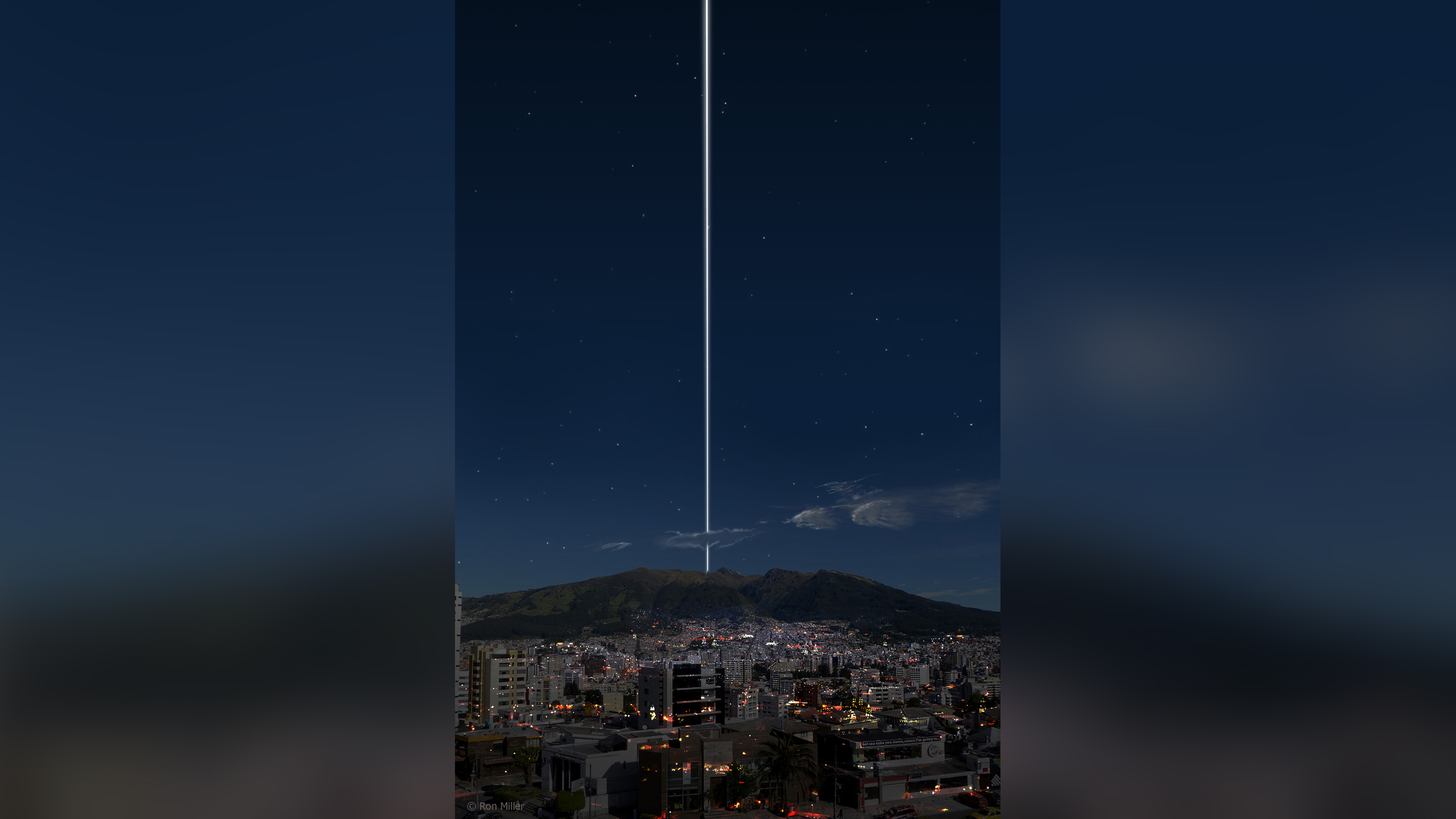
In comparison, near the Arctic Circle, the rings might look like a hump on the horizon.
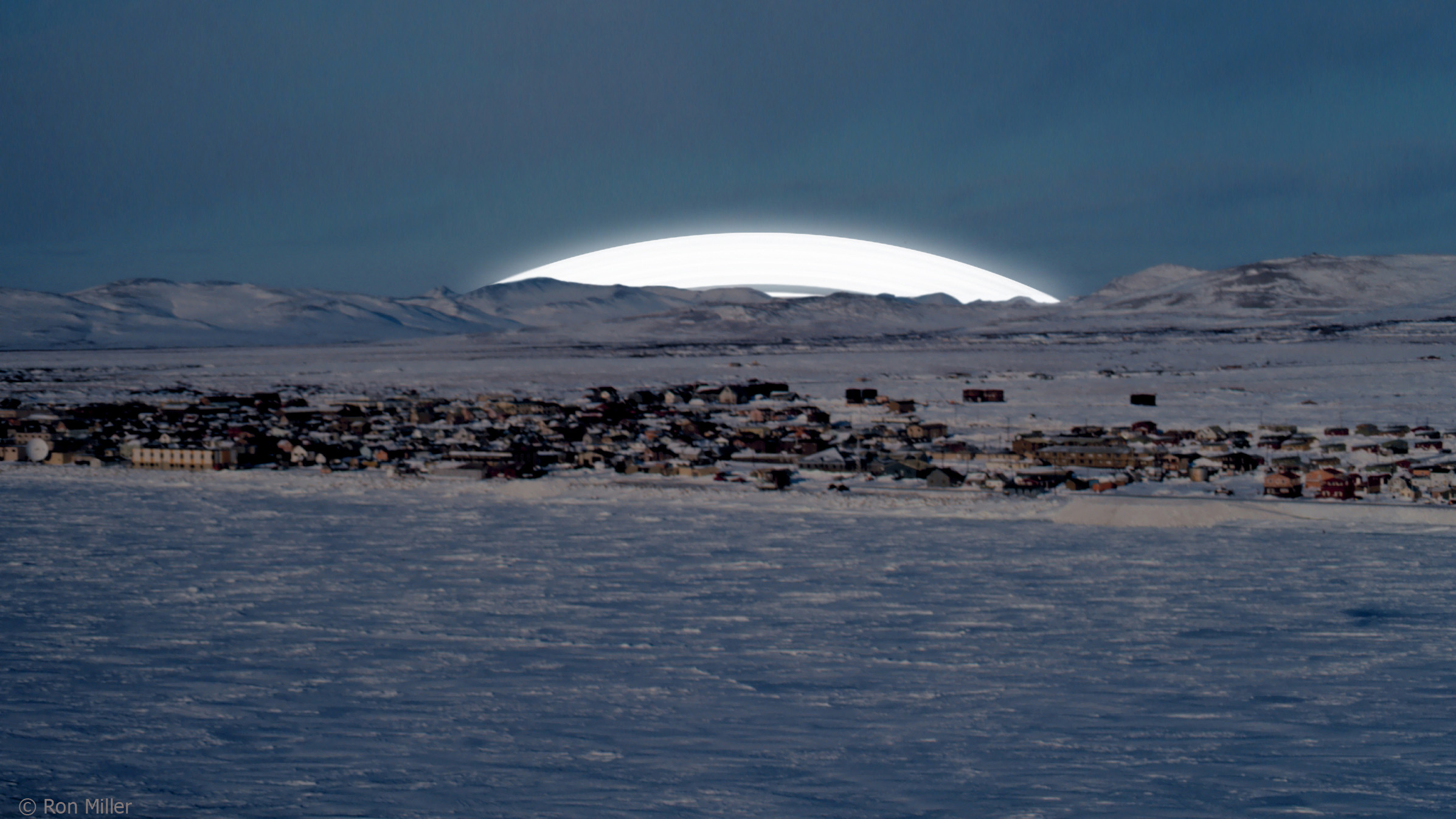
At more temperate latitudes, the rings would look like a giant arch, crossing from one end of the sky to the other.
Get the Space.com Newsletter
Breaking space news, the latest updates on rocket launches, skywatching events and more!
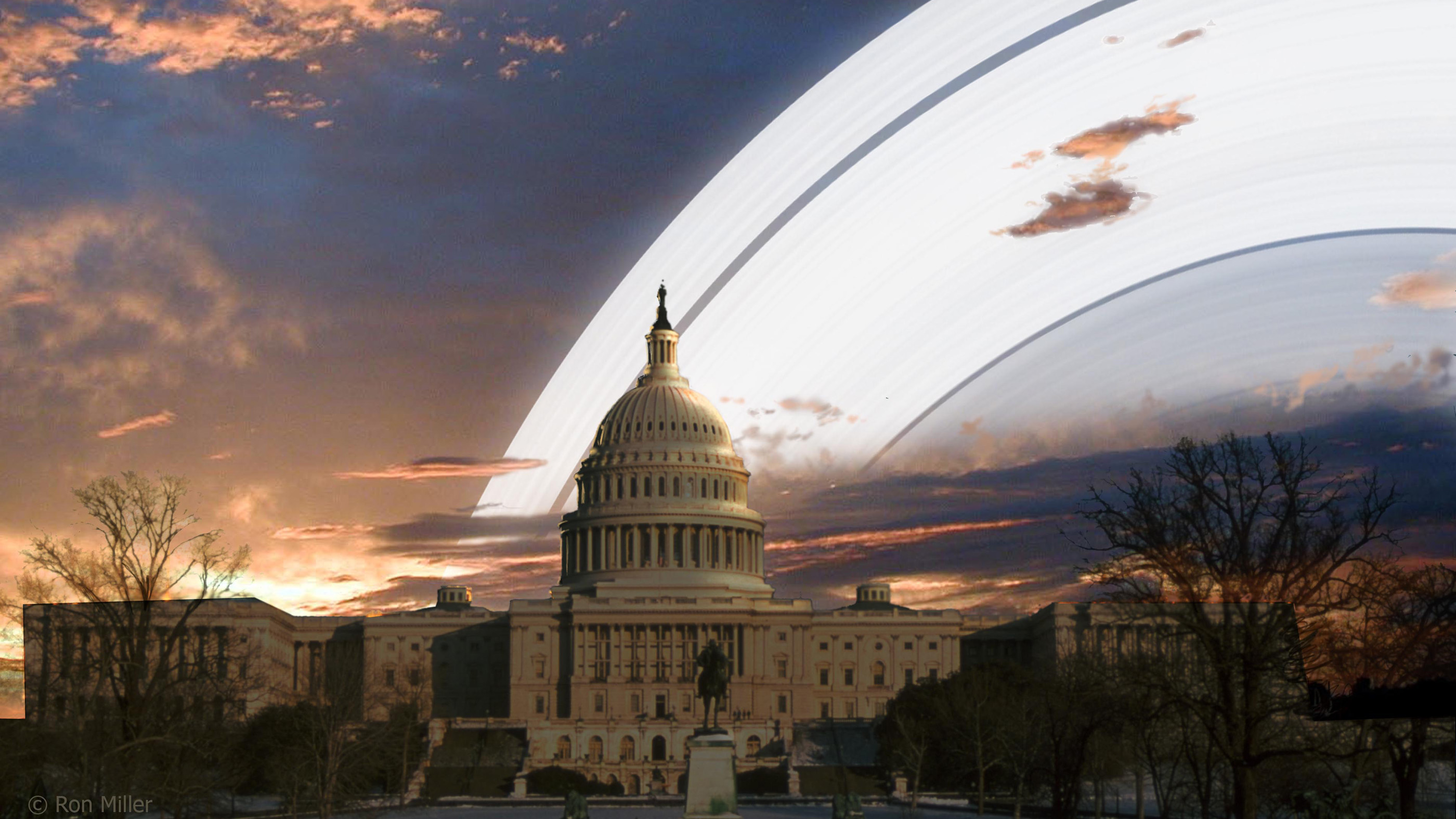
These glittering rings would neither rise nor set, and would always appear in the exact same place in the sky. These cosmic landmarks would be visible both day and night.
Bright rock
Earth's hypothetical rings would differ in one key way from Saturn's; they wouldn't have ice. Earth lies much closer to the sun than Saturn does, so radiation from our star would cause any ice in Earth's rings to sublime away.
Still, even if Earth's rings were made of rock, that might not mean they would look dark. Moon rock is largely grey, and the moon reflects only about 12% of the light falling onto it. But the full moon "looks really bright because there's a lot of light falling on it, and because it's so close to us," said Caleb Scharf, director of astrobiology at Columbia University in New York City.
How bright might Earth's rings get? "About 1,300 watts of sunlight per square meter hits the top of Earth's atmosphere," Scharf told Live Science. "If rings reflected even 10% of that, we're talking about each square meter reflecting as much light as produced by a 130-watt light bulb."
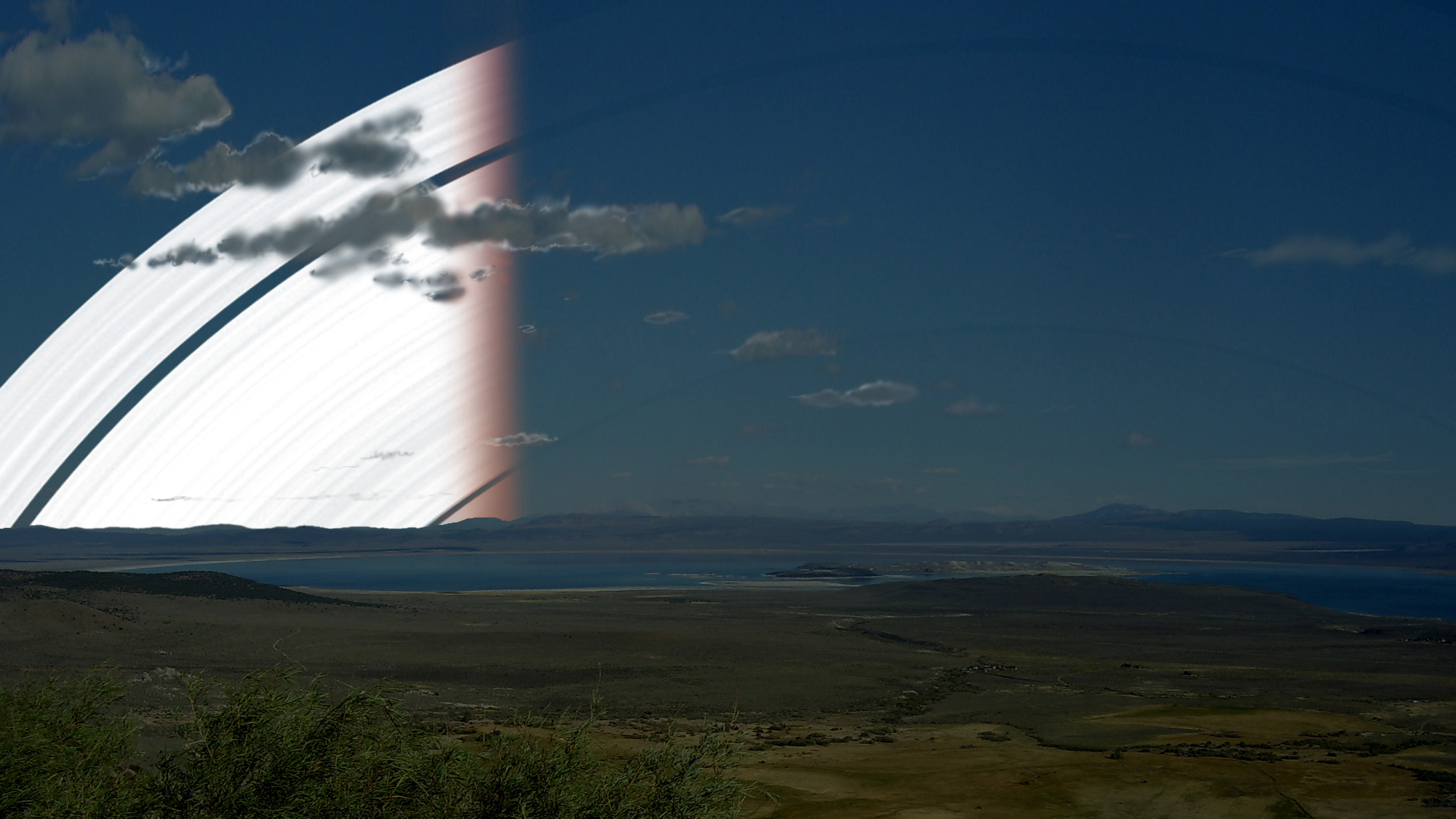
Closer than the moon
How close might the rings get to Earth? Would they interfere with airplanes?
The absolute closest the rings could get is somewhere above the atmospheric layer known as the thermosphere, which reaches up as high as 620 miles (1,000 km), according to the University Corporation for Atmospheric Research. So, commercial airplanes, which typically fly up to 7 miles (11 km), would be fine. (We'll discuss satellites and space travel later.) Meanwhile, atmospheric drag would bring down any ring matter that descended too low. If this happened, the rocky material would burn up like a shooting star in a fiery streak.
Related: Amazing infographic: Earth's atmosphere top to bottom
Just how far might the rings extend from Earth? Any object orbiting within a certain distance of Earth, known as its Roche limit, will break apart due to the force of Earth's gravity. Once broken, these shattered objects would join the rocky ring. For instance, any object the size of Earth's moon that fell below about 7,365 miles (11,850 km) from Earth's surface would disintegrate, forming a ring around the planet.
All in all, Earth's outer rings would likely orbit even closer to our planet than does Earth's moon.
Ring or rings? Moon or moons?
Whether or not Earth sported one ring or many depends on whether Earth also possessed "shepherd moons," small moons that clear gaps between rings and help keep particles confined within a ring, much like a sheepdog keeps sheep from wandering astray. Saturn's rings possess a number of shepherd moons, such as Prometheus. Shepherd moons in Earth's rings might resemble shining pearls circling around the edges of the rings.
It's unlikely Earth could have long-lasting rings if it continues to possess as large a moon as it does now, Scharf said. The same gravitational forces the moon exerts on Earth to cause tides might disrupt the rings, causing them to fall apart, he explained.
Falling shadows
Depending on the time of day, the season and the latitude the viewer is located, Earth's shadow might fall on the rings. Earth's shadow would look oval-shaped on its rings, "and move as time goes by," Scharf said. (Earth's shadow would look oval-shaped instead of circular for much the same reason that your shadow looks stretched out compared to you.)
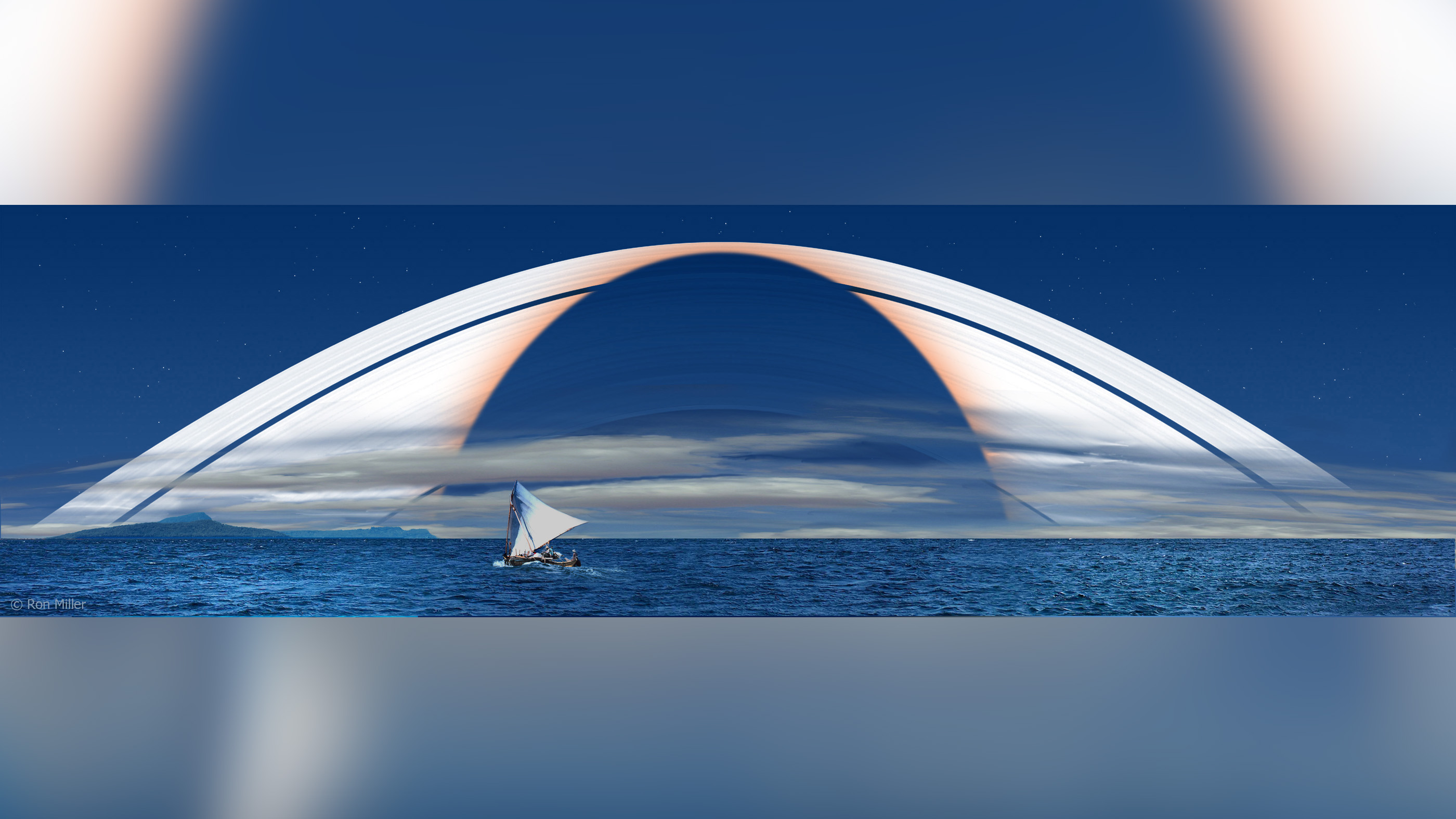
During the equinoxes, the sun would lie on the same plane as the rings. At these times, at Earth's middle latitudes, the planet's shadow would appear to stretch across the rings to its greatest extent, plunging large portions of the rings into darkness. At the equator, the rings would appear to divide the sun, casting a dramatic shadow over half the world.
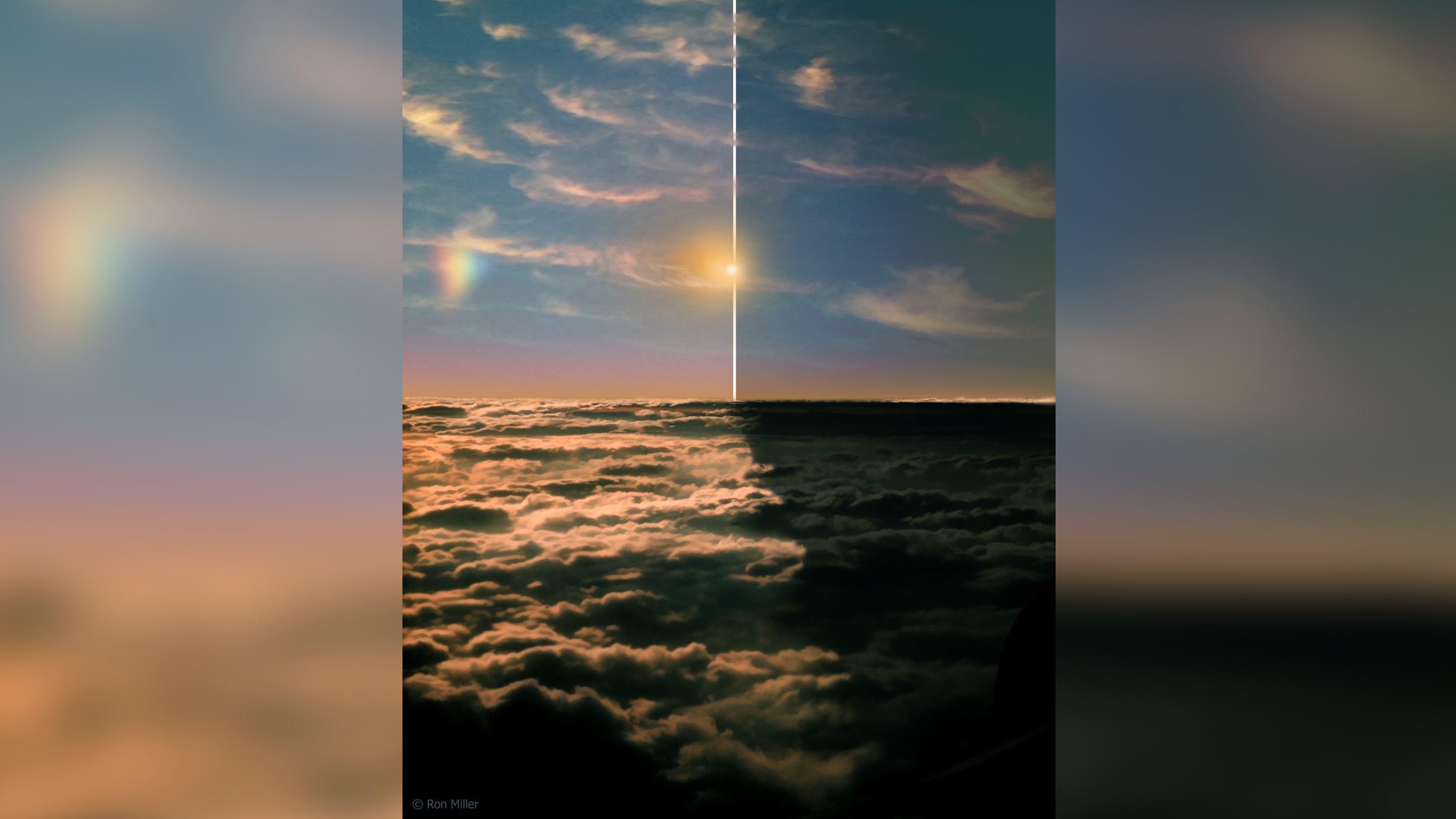
Likewise, the rings themselves would cast shadows on Earth. During the summer in the Northern Hemisphere and the winter in the Southern Hemisphere, the rings would cast their shadows on the Southern Hemisphere, and vice versa. This could mean that winters in both hemispheres might be colder and more severe than they are on our Earth. However, at the same time, "ringshine" might increase the total light Earth receives, "so the climate effects are tricky to pinpoint," Scharf said.
The mythologies surrounding the rings
As celestial landmarks that never change their position in the sky, the rings would almost certainly play a key role in mythologies. At temperate latitudes, one might imagine that the rings' appearance as an arch might symbolize a bridge between heaven and Earth.
Since the rings' appearance changes with latitude, so too might people's interpretations of them. Given how wars on Earth have stemmed from opposing views of religious doctrine, one might wonder what might have happened as ancient people started roaming the planet and seeing the rings change in appearance.
And the rings might very well entice people to wander the world. Given how the rings can resemble giant arches, explorers might want to see where the arches touch down, much like a person aspires to see what's at the ends of a rainbow.
In addition, Scharf noted that around the edges of Earth's shadow on the rings, one would see light that was filtered through Earth's atmosphere. "You might get some funky colors at the shadow's edges, maybe a blood-red rim," he said. "I could imagine all sorts of mythologies built around that."
Moreover, depending on the latitude and the season, the path of the sun may cross behind the rings. The particles making up the rings would likely scatter the sun's light, making it appear hazy or veiled. "It's interesting to think what spiritual significance a civilization might ascribe to the sun going behind the rings," Scharf said.
A guide for navigators
The rings might potentially serve as extraordinary navigational aids. One might wonder how they might support travel, exploration, trade, migration and invasion.
For example, for centuries, sailors had trouble pinpointing their exact position on the Earth in latitude and longitude when they were at sea and out of sight of land. Navigators long had ways of finding their latitude using astronomy — by looking at the altitude of the sun by day or the North Star or Southern Cross by night — but finding a way to calculate longitude took a breakthrough in timepiece engineering.
Rings in the sky could potentially help navigators estimate longitude a number of ways. Shepherd moons could trek around Earth along predictable orbits, like moving hands on a clock. The rings of Saturn possess mysterious spokes, likely related to Saturn's magnetic field, and any spokes on Earth's rings could act like time markers on a clock face. The way that Earth's shadow moves on the rings could also serve as a giant cosmic timepiece. "You could really get a sophisticated kind of timekeeping system with the rings," Scharf said.
The rings and space
Depending on the placement of the rings, satellites and spacecraft could, in principle, orbit underneath them. For instance, the International Space Station orbits about 250 miles (400 km) above Earth's surface, potentially below the rings, whereas geostationary satellites orbit about 22,235 miles (35,786 km) above Earth's surface, likely well above the rings. However, the rings would likely scatter any radio signals from satellites and spacecraft in equatorial orbits, limiting their usefulness.
Still, the rings would likely interfere with astronomy, hindering ground views of the nighttime sky, Scharf said. That might in turn limit what scientists on a ringed planet might know about key details of the cosmos, such as the existence of other galaxies, or the expansion of the universe.
The rings of Mars and Earth
How likely is it that rocky worlds could possess rings? Previous work found that Mars' moon Phobos might once have existed as rings around the Red Planet. As Phobos gets closer to Mars over time, it will likely get torn into a ring again, over the course of millions of years.
It's possible thatEarth already possessed a ring. Our planet was born about 4.5 billion years ago, and previous research suggests the moon arose a short time later. The prevailing explanation for the moon's origin is that it resulted from the collision of two protoplanets, or embryonic worlds. One of those was the newborn Earth, and the other was a Mars-size rock called Theia, named after the mother of the moon in Greek mythology. The impact would have generated a ring of debris around Earth that eventually coalesced into the moon.
In essence, although the vision of a ringed Earth might seem like a fantasy, it might have once — for a moment in time — been true.
Originally published on Live Science.
Join our Space Forums to keep talking space on the latest missions, night sky and more! And if you have a news tip, correction or comment, let us know at: community@space.com.

Charles Q. Choi is a contributing writer for Space.com and Live Science. He covers all things human origins and astronomy as well as physics, animals and general science topics. Charles has a Master of Arts degree from the University of Missouri-Columbia, School of Journalism and a Bachelor of Arts degree from the University of South Florida. Charles has visited every continent on Earth, drinking rancid yak butter tea in Lhasa, snorkeling with sea lions in the Galapagos and even climbing an iceberg in Antarctica. Visit him at http://www.sciwriter.us
-
rod The report stated "It's possible thatEarth already possessed a ring. Our planet was born about 4.5 billion years ago, and previous research suggests the moon arose a short time later. The prevailing explanation for the moon's origin is that it resulted from the collision of two protoplanets, or embryonic worlds. One of those was the newborn Earth, and the other was a Mars-size rock called Theia, named after the mother of the moon in Greek mythology. The impact would have generated a ring of debris around Earth that eventually coalesced into the moon. In essence, although the vision of a ringed Earth might seem like a fantasy, it might have once — for a moment in time — been true."Reply
The giant impact hypothesis for the origin of the Moon calls for at least a 2 lunar mass ring around Earth, just near or outside the Roche limit for the Moon to evolve. 'Implications of Lunar Origin via Giant Impact for the Moon's Composition and the Thermal State of the Protoearth', https://ui.adsabs.harvard.edu/abs/2008LPI....39.2429C/abstract, March 2008
My observation. Using present mass of earth and moon, present lunar orbital eccentricity, the lunar period orbiting at 3.93 earth radii, the period <= 11 hours. The Moon's formation and orbit must change greatly from present parameters seen in astronomy using the giant impact model. The Moon's angular size (using same dimension for the Moon) at 3.93 earth radii is close to 8 degrees angular size in the sky. Thus observing a 2 lunar mass ring system around the early Earth - would be difficult today :) -
Catastrophe RodReply
Congratulations on a really excellent summary.
One point I am missing out on.
Your ref states:
"Results of recent simulations of lunar-forming impacts that include effects of pre-impact rotation in the impactor and the target protoearth are discussed.
When I read your post I really thought I might get something on two questions which have been bothering me for some time. I bow to your superior knowledge in this field and would really appreciate any light on my darkness.
These are:
Rings seem to go both ways. Either they are the result of "body" collisions or they are a stage in the formation of "bodies". Can they do both and, if so, where is the dividing condition?
I have some problems with the Moon and the Roche limit. We are told that the newly formed Moon moved away from the Earth. Is there any infringement with the Roche limit?
Many thanks for any clarification.
Cat :) -
rod Catastrophe, thanks for your post but no bowing :) I have some knowledge here based upon studies on my part for a number of years now on the subject. In my opinion, the giant impact model for the origin of the Moon is an ugly math and tidal forces problem in the equations that pops out various answers and surprises as the numbers are crunched. You asked, "Rings seem to go both ways. Either they are the result of "body" collisions or they are a stage in the formation of "bodies". Can they do both and, if so, where is the dividing condition?Reply
My answer, I do not know here :) Different papers on the giant impact model disclose different problems I see when reviewing. Here is an example, https://ui.adsabs.harvard.edu/abs/2016arXiv161102769W/abstract, "...The main concern was that models were multi-staged and too complex. Here, we present initial impact conditions that produce an Earth-Moon system whose angular momentum and isotopic properties are correct. The model is straightforward and the results are a natural consequence of the impact." The arXiv paper is at https://arxiv.org/ftp/arxiv/papers/1611/1611.02769.pdf
So far, from what I can gather, the early Moon forms at or near Earth's Roche limit or close to 3 earth radii distance. Today the Moon orbits close to 60.3 earth radii for the mean. Another shorter report, https://skyandtelescope.org/astronomy-news/when-and-how-did-the-moon-form/
The initial angular momentum of the Earth-Moon system is difficult and the initial length of day too for the Earth, e.g. this report has a 5 hour day, https://phys.org/news/2016-10-theory-moon.html
https://ui.adsabs.harvard.edu/abs/2016Natur.539..402C/abstract, November 2016. This paper has a 2.5 hour initial length of day for the Earth. Changing different parameters here can result in some real differences in the formation of the Moon too.
Catastrophe, I still collect information on this subject from time to time. Showing the giant impact model, *warts in all* I think is still a work in progress :) -
Catastrophe RodReply
Many thanks for your detailed reply. It will take me some time to digest. I do so much appreciate how much you have put into this. Best wishes,
Cat :)










